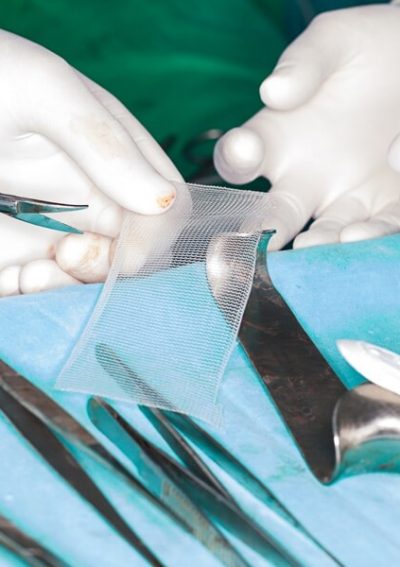Hernia Mesh Lawsuits
Hernia mesh lawsuits allege defective designs, manufacturing flaws and failure to warn patients of risks. Thousands of cases remain active, but others have resulted in significant settlements. These settlements include recent agreements from Bard and Ethicon to resolve severe injuries and complications claims.

Latest Updates in Hernia Mesh Lawsuits
As of July 2025, 26,491 total hernia mesh lawsuits were pending in four multidistrict litigations against Atrium (392 cases), Covidien (2,040 cases), C.R. Bard (24,050 cases) and Ethicon (9 cases). People continue to file lawsuits.
In February 2025, though the number of lawsuits continued to rise, many existing suits were recently (or will soon be) dismissed due to previous settlements.
In October 2024, Becton Dickinson announced a confidential settlement. This deal aims to resolve the “vast majority” of hernia mesh lawsuits against the company and its subsidiary, Bard. This will likely apply to many cases in the ongoing Bard MDL.
Atrium is the defendant in MDL 2753 before Chief Judge Landya B. McCafferty of the U.S. District Court for the District of New Hampshire. Covidien is the defendant in MDL 3029 before Chief Judge Patti B. Saris of the District of Massachusetts. Davol, Inc./C.R. Bard, Inc. is the defendant in MDL 2846 before Chief Judge Edmund Albert Sargus, Jr. of the Southern District of Ohio. Ethicon is the defendant in MDL 2782 before Senior District Judge Richard W. Story of the Northern District of Georgia.
-
April 2025
The first two bellwether trials in the Covidien MDL have been scheduled for February 2026 and July 2026. The outcome of these trials could play a notable role in the outcome of the litigation.
-
January 2025
The judge ordered the establishment of a settlement fund related to the Hernia Mesh Bard multidistrict lawsuit.
-
November 2024
Judge Landya B. McCafferty approved a fund to compensate people injured by Atrium Medical Corporation's C-Qur Mesh used in hernia surgeries. While a final settlement hasn't been reached, ongoing talks suggest the company is willing to address these claims. Additional plaintiffs received settlements from Ethicon. The number of pending hernia mesh lawsuits against Covidien rose to 1,546, and Covidien was compelled to turn over outstanding documents. Two special masters now oversee the settlement process for Bard's products. A special master is a person a judge picks to help with a court case. This person is usually an expert in something important to the case, like money, medical records or technical rules.
-
October 2024
Becton Dickinson announced that a confidential settlement agreement had been reached. This has ended most cases against Bard. However, it was discovered that Bard and Covidien were still selling injurious hernia mesh products, so many more lawsuits are expected.
-
September 2024
With 1,472 pending cases, the hernia mesh case against Covidien became the 17th largest MDL in the country.
-
February 2024
The judge presiding over the Bard case declared there would be no further trials. Relevant parties were ordered to attempt to reach a settlement agreement. Cases against Covidien began to grow and move forward.
-
January 2024
At the beginning of the month, the MDL against Bard included over 20,000 filed cases. Litigation began over five years ago.
-
December 2023
Johnson & Johnson and its subsidiary Ethicon reached settlement agreements with 224 plaintiffs in the MDL. The amounts were not specified.
-
October 2023:
October 2023: C.R. Bard’s third bellwether test trial was scheduled to begin.
-
April 2023
Ethicon dismissed several cases from the MDL, which remains open despite a confidential settlement in September 2021.
-
March 2023:
The judge rescheduled Stinson v. C.R. Bard et al., the third hernia mesh bellwether trial, for October 16, 2023. The trial was initially scheduled for May 2023, but the MDL Judge granted C.R. Bard’s request to postpone the trial.
-
April 2022:
In the second bellwether trial, a jury awarded Antonio Milanesi a $255,000 verdict against C.R. Bard.
-
December 2021
A judge granted a Motion to Establish a Qualified Settlement Fund in the Atrium MDL. The settlement terms are confidential, but Atrium reportedly set aside $66 million.
-
September 2021
Ethicon agreed to a confidential global settlement.
Why Are People Filing Hernia Mesh Lawsuits?
People who have filed hernia mesh lawsuits argue that the mesh failed. They report that it caused significant injuries, requiring at least one revision surgery. A hernia occurs when part of an organ protrudes through a muscular wall. A mesh reinforces the tissue surrounding that organ to stop the organ from protruding. However, some plaintiffs required multiple surgeries, and others claim their complications continued after revision surgery.
- Defective product design
- Improper product labeling, failing to warn patients and doctors about the risk of mesh failure and complications
- Defective product manufacturing
- Malpractice from the plaintiff’s doctor who implanted the faulty mesh
Lawsuits seek compensation for lost wages and medical bills. They also name damages, including pain, suffering and loss of quality of life.
Complications Listed in Lawsuits
People who filed lawsuits suffered severe hernia mesh complications that required additional surgery. Mesh failure happens when the implant leads to problems. These can include hernia recurrence or pain, which may require removing the mesh.
- Adhesion: Hernia mesh sticks to tissue or other organs.
- Bowel Obstruction: Hernia mesh sticks to the intestines or moves, blocking the bowel.
- Groin or Testicular Pain: Pinched nerves lead to a burning sensation at the surgery site.
- Hernia Recurrence: Mesh failure to prevent hernias from recurring is a common complication.
- Infection: Chronic inflammation around the hernia mesh can lead to infection.
- Migration: Hernia mesh moves from the surgery site to other parts of the body.
- Pain: Chronic pain may lead to nerve damage or chronic inflammation.
- Perforation of Organs or Tissues: Other body parts can be punctured when mesh migrates.
- Seromas: Pockets of fluid build up around the surgery site.
- Revision Surgery: Patients may need one or more surgeries to remove faulty hernia mesh.
Symptoms that can require hernia mesh removal include urinary problems, fever or swelling at the surgery site. Delayed or long-term complications can also happen. These include adhesions, hernia recurrence or chronic pain that may occur years after the original surgery.
Who Qualifies for a Hernia Mesh Lawsuit?
To qualify for a hernia mesh lawsuit, you must have experienced severe complications from mesh named in lawsuits. You must also file your claim within the statute of limitations.
“The people that are eligible for filing a hernia mesh claim would be folks who have had complications after a hernia mesh surgery,” Hernia mesh attorney Daniel Nigh told ConsumerNotice. “So, for example, if you’ve had or if you’re scheduled for a revision surgery or you’ve had a revision of your hernia mesh, you should contact a lawyer as soon as possible.”
- You had hernia repair surgery with mesh on or after January 1, 2006.
- You experienced severe injuries, including adhesions, hernia recurrence, intestinal blockage, mesh migration, organ perforation or infection more than 30 days from the original surgery date.
- You required hernia revision surgery or additional surgery because of complications.
An experienced medical injury lawyer can help you determine your lawsuit eligibility. The sooner you contact an attorney, the better your chance of achieving a settlement.
Manufacturers and Brands Named in Litigation
Patients have filed lawsuits against several major hernia mesh manufacturers in federal and state courts. Though other manufacturers are affected, as of early 2025, the primary manufacturers involved at any level are Atrium, Bard Davol (C.R. Bard and Davol Inc.), Johnson & Johnson subsidiary Ethicon, W.L. Gore & Associates and Covidien/Medtronic.
| Manufacturer | Models Included in Lawsuits (incomplete) |
|---|---|
| Atrium | C-Qur products, including:
|
| Bard Davol | All polypropylene products, including:
|
| Covidien/Medtronic | Paratietene, Paraietex, Surgipro and Symbotex models, including:
|
| Ethicon | |
| W.L. Gore & Associates |
Hernia mesh manufacturers such as Medtronic produce over 70 different mesh brands. Atrium is also a major manufacturer that dominates the U.S. market.
Hernia mesh is a net-like implant typically made from polypropylene plastic, which is non-absorbable and synthetic. Some synthetic meshes are coated with a physical barrier, such as omega-3 fatty acids or collagen. These barriers are supposed to reduce the body’s inflammatory response. Another type of hernia mesh is biologic mesh, manufactured from disinfected animal tissue and absorbed into the body over time.
Hernia Mesh Multidistrict Litigation vs. Class Action Lawsuits
Multidistrict litigation (MDL) is a legal process that centralizes and transfers similar civil lawsuits from different parts of the country to one judge. Each lawsuit remains separate but addresses common questions of fact simultaneously. MDLs reduce the burden on the courts and make litigation less costly and more efficient.
- Atrium: As of July 2025, 392 pending C-QUR mesh lawsuits were pending.
- Bard Davol: As of July 2025, there were 24,050 pending lawsuits for polypropylene products and hernia mesh.
- Ethicon: As of July 2025, there were 9 pending Physiomesh Flexible Composite hernia mesh lawsuits.
A multidistrict litigation differs from a class action lawsuit. In class action lawsuits, the case combines individual plaintiffs into a single suit. In MDLs, however, the court groups similar cases and decides them in one or a few bellwether trials.
In a bellwether trial, a few of the many cases in an MDL are chosen for individual trials. This is intended to help involved parties anticipate how related future litigation will turn out.
Compensation for Hernia Mesh Injuries
Plaintiffs filing hernia mesh lawsuits claim compensation for economic losses, non-economic losses and, in some cases, punitive damages. Financial losses include past and future medical expenses and wage losses. They also include the cost of any additional surgery the plaintiff may require to fix the original complications.
Non-economic losses relate to compensation for emotional and mental distress. For example, one plaintiff experienced sexual difficulty because of hernia mesh surgery. This category of damages addresses the loss of quality and enjoyment of life.
If a relative files a wrongful death lawsuit over hernia mesh issues, they might get economic or non-economic damages. These can cover the victim’s suffering, the challenges faced after their death, or both.
Verdicts and Settlements
There have been several verdicts and settlements in hernia mesh cases, some as high as $1.5 million.
Bard’s parent company, Becton Dickinson, announced in October 2024 that it had agreed to a confidential settlement to resolve the vast majority of hernia mesh lawsuits against the company. A settlement fund was created in January 2025.
Bard had lost three bellwether trials in a row, with verdicts ranging from $250,000 to $4.8 million. In the recent bellwether trial of November 2023, a jury reached a $500,000 verdict in favor of the plaintiff, Aaron Stinson.
A jury ordered Bard to pay $1.5 million to one plaintiff in a Kugel patch lawsuit in 2010. The mesh maker also paid $184 million to settle 2,600 lawsuits, closing the Kugel Patch MDL.
Editor Lindsay Donaldson contributed to this article.
26 Cited Research Articles
Consumernotice.org adheres to the highest ethical standards for content production and references only credible sources of information, including government reports, interviews with experts, highly regarded nonprofit organizations, peer-reviewed journals, court records and academic organizations. You can learn more about our dedication to relevance, accuracy and transparency by reading our editorial policy.
- United States Judicial Panel on Multidistrict Litigation. (2025, July 1). MDL Statistics Report - Distribution of Pending MDL Dockets by Actions Pending. Retrieved from https://www.jpml.uscourts.gov/sites/jpml/files/Pending_MDL_Dockets_By_Actions_Pending-July-1-2025_0.pdf
- U.S. District Court, District of Massachusetts. (2025, April 28). Order for Pretrial Conference. Retrieved from https://ecf.mad.uscourts.gov/doc1/095112923773
- U.S. District Court, District of Massachusetts. (2025, April 8). Order for Pretrial Conference. Retrieved from https://ecf.mad.uscourts.gov/doc1/095112886882
- In re: Davol, Inc./C.R.Bard, Inc, Polypropylene Hernia Mesh Products Liability Litigation. (2024, October 15). Amended Short Form Complaint. Retrieved from https://www.robertkinglawfirm.com/wp-content/uploads/2024/10/amended-short-form-complaint-davol-bard-hernia-mesh.pdf
- BD. (2024, October 2). BD Reaches Agreement to Resolve Vast Majority of Hernia Litigation. Retrieved from https://news.bd.com/2024-10-02-BD-Reaches-Agreement-to-Resolve-Vast-Majority-of-Hernia-Litigation
- U.S. Food and Drug Administration. (2023, July 13). Surgical Mesh for Hernia Repair: FDA Activities. Retrieved from https://www.fda.gov/medical-devices/hernia-surgical-mesh-implants/hernia-surgical-mesh-implants-fda-activities
- U.S. Food and Drug Administration. (2023, July 13). Surgical Mesh Used for Hernia Repair: Reporting Problems to the FDA. Retrieved from https://www.fda.gov/medical-devices/hernia-surgical-mesh-implants/hernia-surgical-mesh-implants-reporting-problems-fda
- U.S. Food and Drug Administration. (2023, July 13). Surgical Mesh Used for Hernia Repair. Retrieved from https://www.fda.gov/medical-devices/implants-and-prosthetics/hernia-surgical-mesh-implants
- Singh, V. (2023, February 21). U.S. Supreme Court Refuses to Reject $302M Judgment Against Johnson & Johnson Over Pelvic Mesh Marketing. Retrieved from https://finance.yahoo.com/news/us-supreme-court-refuses-reject-201134356.html
- Pierson, B. (2022, August 29). R.I. Jury Orders Becton Dickinson to Pay $4.8 Mln in Hernia Mesh Trial. Retrieved from https://www.reuters.com/legal/litigation/ri-jury-orders-becton-dickinson-pay-48-mln-hernia-mesh-trial-2022-08-29/
- Pierson, B. (2021, July 30). Becton Dickinson Faces First Bellwether Trial Over Hernia Mesh. Retrieved from https://www.reuters.com/legal/litigation/becton-dickinson-faces-first-bellwether-trial-over-hernia-mesh-2021-07-30/
- In re: Ethicon Physiomesh Flexible Composite Hernia Mesh Products Liability Litigation. (2021, May 18). Practice and Procedure Order No. 27. Retrieved from https://www.gand.uscourts.gov/sites/gand/files/rws2782_doc745.pdf
- U.S. District Court, Northern Dist. of Georgia. (2019, January 17). In re: Ethicon Physiomesh Flexible Composite Hernia Mesh Products Liability Litigation; MDL No. 2782; Practice and Procedure Order No. 15. Retrieved from https://www.gand.uscourts.gov/sites/gand/files/rws2782_doc425.pdf
- U.S. Food and Drug Administration. (2018, October 5). Class 2 Device Recall Parietex Composite Parastomal Mesh. Retrieved from https://www.accessdata.fda.gov/scripts/cdrh/cfdocs/cfres/res.cfm?id=168668
- Supreme Court of New Jersey. (2018, August 15). Notice and Order -- Designation of Physiomesh Flexible Composite Mesh Litigation as Multicounty Litigation (MCL). New Jersey Courts. Retrieved from https://www.njcourts.gov/notices/notice-and-order-designation-of-physiomesh-flexible-composite-mesh-litigation-multicounty
- U.S. District Court, Southern Dist., Ohio. (2018, August 2). Introduction – MDL 2846. Retrieved from https://www.ohsd.uscourts.gov/introduction-mdl-2846
- U.S. District Court, Dist. of New Hampshire. (2018, May 29). In re: Atrium Medical Corp. C-QUR Mesh Products Liability Litigation (MDL No. 2753); Case Management Order 3h. Retrieved from http://www.nhd.uscourts.gov/pdf/Atrium_CMO3H.pdf
- U.S. District Court, Northern Dist. of Georgia. (2018, May 29). In re: Ethicon Physiomesh Flexible Composite Hernia Mesh Products Liability Litigation; Practice and Procedure Order No. 11. Retrieved from https://www.gand.uscourts.gov/sites/gand/files/rws2782_doc345.pdf
- U.S. District Court, Western Dist. of Missouri. (2018, January 18). Rowe v. Davol, Inc., et al.; Jury Trial Demanded; Civil Action No.: 6:18-cv-3019. Retrieved from https://www.aboutlawsuits.com/wp-content/uploads/2018-1-18-perfix-plug-rowe-complaint.pdf
- U.S. Judicial Panel on Multidistrict Litigation. (2017, June 2). In re: Ethicon Physiomesh Flexible Composite Hernia Mesh Products Liability Litigation; MDL No. 2782; Transfer Order. Retrieved from https://www.jpml.uscourts.gov/sites/jpml/files/MDL-2782-Initial_Transfer-05-17.pdf
- U.S. Food and Drug Administration. (2017, January 28). Hernia Surgical Mesh Implants: Information for Patients. Retrieved from https://www.fda.gov/medical-devices/hernia-surgical-mesh-implants/hernia-surgical-mesh-implants-information-patients
- U.S. Judicial Panel on Multidistrict Litigation. (2016, December 8). In re: Atrium Medical Corp. C-QUR Mesh Products Liability Litigation; MDL No. 2753; Transfer Order. Retrieved from https://www.jpml.uscourts.gov/sites/jpml/files/MDL-2753-Initial_Transfer-12-16.pdf
- U.S. Food and Drug Administration. (2007, January 10). Class 1 Device Recall Davol Composix Kugel Hernia Patch. Retrieved from https://www.accessdata.fda.gov/scripts/cdrh/cfdocs/cfRES/res.cfm?id=49722
- U.S. Food and Drug Administration. (2005, December 22). Class 1 Device Recall Bard. Retrieved from https://www.accessdata.fda.gov/scripts/cdrh/cfdocs/cfRES/res.cfm?id=43767
- Town of Merrimack New Hampshire. (n.d.). Merrimack Business Profiles. Retrieved from https://www.merrimacknh.gov/economic-development/pages/merrimack-business-profiles
- United States District Court, Southern District of Ohio. (n.d.). Multidistrict Litigation 2846. Retrieved from https://www.ohsd.uscourts.gov/multidistrict-litigation-2846
Calling this number connects you with a Consumer Notice, LLC representative. We will direct you to one of our trusted legal partners for a free case review.
Consumer Notice, LLC's trusted legal partners support the organization's mission to keep people safe from dangerous drugs and medical devices. For more information, visit our partners page.
855-877-5976

